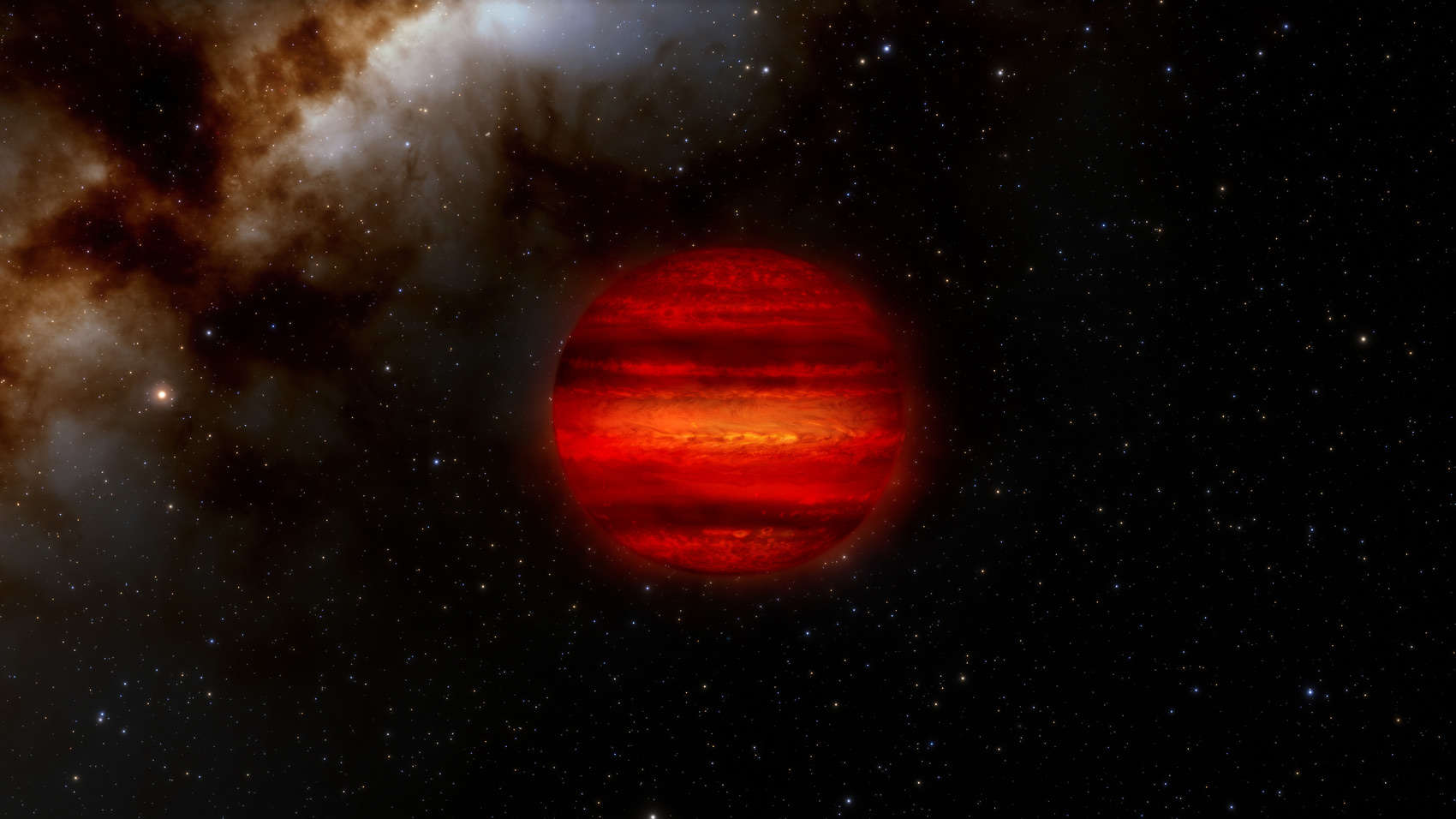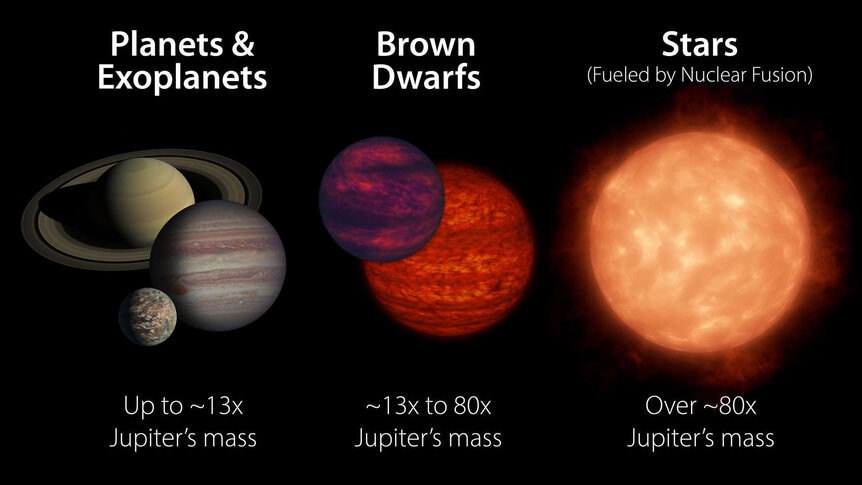Create a free profile to get unlimited access to exclusive videos, sweepstakes, and more!
If these brown dwarfs spun much faster they'd tear themselves apart

Astronomers have found three brown dwarfs — objects more massive than planets but less so than stars — that are the most rapidly rotating of any known. These beasts spin so dizzyingly fast they rotate about once per hour.
That's phenomenal. Think of it this way: They are about the same size as Jupiter, but that giant planet in our solar system spins once every ten hours. These objects spin ten times faster.
Or how about this: Standing on Earth's equator you'd experience a sideways velocity due to Earth's spin of about 1,700 kilometers per hour. Standing on the equator of one of these brown dwarfs that you'd be moving more like 375,000 kph!
Whoa. In fact, they're spinning so rapidly that the centrifugal force outward is nearly equal to their gravitational force inward. In other words, if they spun much faster they'd literally fly themselves apart.
I love everything about this story.
Brown dwarfs are fascinating objects. They are sometimes called “failed stars”, which I think is unfair (who's to say they aren't really successful planets?). They form like stars, collapsing from interstellar clouds of gas and dust, but don't quite get enough mass to create sustained nuclear fusion in their cores (which is what defines a star). They're hot when they first form, and slowly cool off over time.
Generally speaking they have a mass range of roughly 13–75 times the mass of Jupiter; anything lower mass than that is more like a planet, and anything more massive is a star. Weirdly, though, a quirk of physics keeps them pretty small. If you add mass to an object like Jupiter it doesn't get bigger, it gets denser. So a massive brown dwarf is only a bit bigger than Jupiter, but far more massive, making them on average denser than iron! They're weird objects, these brown dwarfs.
In some ways they look like planets, and can have storms in their upper atmospheres. These can be bright features, and as the brown dwarf rotates we see it come into and out of our view. Now, brown dwarfs are too far away to see as anything other than dots in our telescopes, but as a bright spot rotates into view we see the dwarf get brighter, then dimmer again as the storm rotates away onto the far side. So, by monitoring their brightness we can determine their rotation speed.
… but of course it's not that simple. What if there are two storms on opposite sides of the dwarf? If we thought they were a single storm we'd mistakenly calculate a rotation speed two times faster than it really is.
To check for that, astronomers took spectra of the brown dwarfs. This breaks the light up into individual wavelengths (think of them as color). Some atoms and molecules in the atmosphere absorb and emit light at pretty specific colors, and these show up as a raised blip or a narrow dip in the spectrum.
If the brown dwarf spins rapidly, these features get smeared out due to the Doppler effect, where light gets shifted a bit in wavelength as an object approaches or recedes from us. When an object spins, part of it moves toward us and part moves away, so the overall effect is to broaden the spectral features in wavelength.
The astronomers used the Spitzer Space Telescope to examine 25 bright brown dwarfs to look for various properties. Three of them displayed the ridiculously fast rotation speeds. If you're keeping track at home their names are 2MASS J04070752+1546457, 2MASS J12195156+3128497, and 2MASS J03480772−6022270. I'll just leave those alphanumeric salads there for you. But the astronomers found rotational periods (the brown dwarfs' “days”) of 1.23, 1.14 and 1.08 hours, respectively.
The record before this was 1.41 hours, so these are clearly winners.
I'll note that the measured rotational speed in km/hr may actually be higher! This number depends in part on how they're tilted with respect to us; if we're seeing them more pole-on their real velocity is even higher.
How close are they to breaking up due to their high spin speed? That's harder to know. It depends on their mass and radius; the bigger they are the more outward force they generate at a given speed, but the more massive they are the higher their gravity is and the harder it pulls material toward the center, offsetting the rotation. Still, the scientists found that they appear to be spinning at about half the speed necessary to fly apart. That's impressive.
In fact when they look at known spin rates of brown dwarfs, there appears to be a cluster of them near this top rate. That may be because ones that spin faster do in fact lose material, which slows their spin. So this may be about as rapidly as we'll ever see any brown dwarf spin.
Another effect is that a spinning object will flatten out at the equator, becoming oblate, like a beach ball someone is sitting on. This can be easily seen with Jupiter and Saturn, and in fact Saturn is the most oblate object in the solar system due to rotation; it's about 10% smaller through its poles than across its equator. Doing the calculations, the astronomers find the brown dwarfs are about 5-8% flattened.
Again, impressive, given their surface gravity is about 100 times Earth's. If they weren't spinning, standing on the equator I'd weigh over 7 tons! But due to their spin I'd only feel my weight being a little more than it is now (um, considerably less than 7 tons). Maybe twice as much, so not bad.
So why do they spin this rapidly? It's possible they were born rotating rapidly, as material fell onto the objects and they grew, increasing their spin. Maybe ones at this end of the rotation scale collided with and absorbed other objects (other brown dwarfs or planets) which spun them up. It's hard to say.
The first brown dwarfs were only discovered in the 1990s, and we're still learning about their basic properties. That's reflected in the fact that they can still surprise us! I hope there are still lots more such surprises to be found. In science, that's generally the way to bet.



























